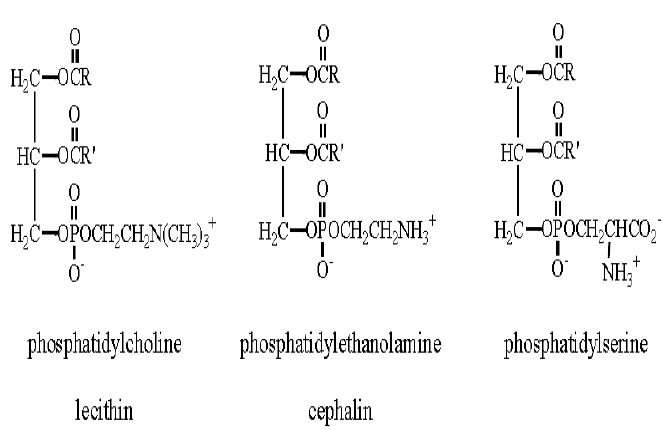Chapter: Basic Concept of Biotechnology : Biomolecules
Phospholipids
Phospholipids
There are two classes of phospholipids. The first are the glycerophospholipids, which are themselves subdivided into two groups. The first group, phosphatides, is molecules composed of glycerol substituted with two fatty acid esters (just like in fats) and at the third position a phosphate unit connects to an alcohol.

Three alcohols that form phosphatides are choline, ethanolamine, and serine. These compounds are important to the body and are transported as the following phosphatides. The enzymes either cut the molecule free when it is needed or convert it to some other necessary material. The phosphate group and the organic chain attached to it carry electrical charges three phosphatides are components of cell membranes.
Choline is a water-soluble vitamin (as recognized by the Food and Nutrition Board, usually classified as a B vitamin) used to make complex lipids. Phosphatidylcholine is the principal phospholipid of cell membranes. It is also converted to acetyl choline (CH3CO2CH2CH2N (CH3)3+), which is an important neurotransmitter (it carries electrical charges from one nerve cell to another). Choline helps break down homocysteine – a cardiovascular disease risk factor. A lack of this vitamin leads to fatty livers and/or hemorrhagic kidney disease. Serine is the parent of a family of amino acids that also includes glycine and cysteine. Enzymes convert serine (as part of phosphatidylserine) to glycine and cysteine. Serine is also involved in the generation of ethanolamine, which is in turn converted to choline. Interestingly, phosphatidylethanolamine is deficient in Alzheimer’s patients. They also act as a histamine blocker in the body. The other subclass of glycerophospholipids is the plasmalogens. These differ from triacylglycerols by even more than the phosphatides. A generic plasmalogen would look like:

The compound with R = CH3 is called platelet activating factor. It is a strong bronchoconstrictor. It also stimulates other cells to increase their functional and metabolic activities.
The second major class of phospholipids is the sphingolipids. Sphingolipids include the sphingomyelins and cerebrosides. Both are based on the molecule sphingosine. Sphingomyelins have the basic formula:

As the name suggests this lipid is affiliated with the myelin sheath surrounding the cells of the central nervous system. Sphingomyelins comprise about 25% of the lipids in the myelin sheath and their role is key to brain function and electrical transmission throughour nervous system. The other type of sphingolipids we are concerned with are cerebrosides, which are not phospholipids. These compounds are again based on attachments to a sphingosine molecule.

Not surprisingly, these molecules are called glycolipids (cf. glycosides are acetals of sugars). Most of these molecules incorporate Ăź-D-galactose sugars. Cerebrosides are found most commonly in cell membranes in the brain. One cerebroside found outside the brain, a glucocerebroside, is found in the membranes of macrophages (cells that destroy foreign microorganisms). Several disorders are associated with malfunctioning of sphingolipid metabolism. Probably the best known is Tay-Sachs disease, which strikes infants and is typically fatal by age 3. Niemann-Pick disease also strikes infants and is fatal early in life.
Gaucher’s disease and Fabry’s disease strike later in life and are generally less devastating.
Related Topics